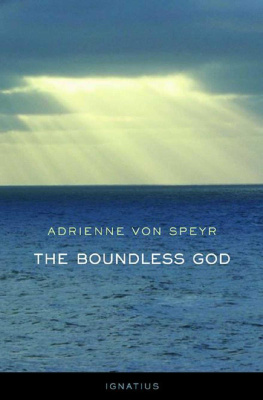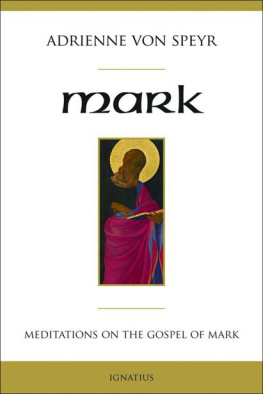THE WORLD OF PRAYER
ADRIENNE VON SPEYR
THE WORLD OF PRAYER
WITH A FOREWORD BY
HANS URS VON BALTHASAR
Translated by Graham Harrison
IGNATIUS PRESS SAN FRANCISCO
Title of the German original:
Die Welt des Gebetes
1951 Johannes Verlag
Einsiedeln, Switzerland
Cover by Victoria Hoke
With ecclesiastical approval
1985 Ignatius Press, San Francisco
All rights reserved ISBN 978-0-89870-033-6
Library of Congress catalogue number 84-080904
CONTENTS
I.
II.
Expectation and Fulfillment. Believing, Beholding, Loving. Action and Contemplation. Worship. Petition. Decision .
The Prayer of Incarnation. Adoration. Petition. Contemplation .
The Child. The Growing Girl. Prior to the Angels Appearance. The Angel. Pregnancy. Birth. Flight to Egypt. The Childhood of Jesus. The Search for the Twelve-Year-Old. Alone in Nazareth. At the Cross. After the Resurrection. After the Ascension. Death .
III.
IV.
V.
VI.
VII.
The Saint. The Priest. The Believer .
VIII.
IX.
FOREWORD
The uniqueness of Adrienne von Speyrs writings makes it appropriate for the editor to give a brief word of explanation. Most of the works which have appeared so far were meditations on Holy Scripture, an endeavor to hear and interpret the Word of God afresh verse by verse. The effort involved in this tireless determination to begin afresh will make sense to the reader at each step only if he undertakes the same effort just as tirelessly, seeing what is presented to him, not as a connected treatise, but as an intellectual stimulus, an invitation to his own meditation. The same is true of this volume, despite its external form. The editor has selected some of the authors numerous observations on the subject of prayer, putting them together like flowers in a bouquet. Like all bouquets, there is something arbitrary about it: It could have been larger, smaller or differently arranged. The reader should pay less attention to the external arrangement, which, including the titles and headings, is the work of the editorand which would probably be incomplete in whatever form it were presentedthan to the substance and value of the individual pieces, which reveal an unmistakably unified style of thought and approach to prayer and indeed to the whole of Christian life. Strange as it may seem, it hardly matters where one opens this book and begins to read: All paths lead straight to the center like sectors of a circle. The readers attention should be directed in all respects to the inner, not the outer, unity.
Initially we can say that this unity lies in the fact that every human perspective needs to be traced to and grounded in an ecclesial perspective, every ecclesial perspective within a christological one and every christological perspective within a trinitarian one. Here we find the fundamental idea of the book, audacious and yet entirely logical: Like everything that comes to man through Gods self-revelation in Christ (such as grace, faith, hope and love, the relationship between Christ and the Church), prayer is ultimately rooted in God himself and in his triune exchange of life. Beyond all purely creaturely motives and needs, Christian prayer is a participation in the inner life and prayer of the Divinity, which is revealed, prepared and accomplished in the world by Jesus Christ our Lord and by him made available for us to take part in. Since this idea is the core of the book, the section dealing expressly and most completely with the trinitarian basis of prayer has been placed at the beginning, in spite of various reasons against this plan. Readers who are less inclined to follow demanding theological trains of thought would be advised, after having read the Introduction, to skip over this section initially, along with the chapter on the prayer of Christ, and to begin with either the chapter on the prayer of Mary (a chapter which is complete in itself, since it was written for a particular occasion) or the one on the development of prayer in man. In reading those later chapters, readers will continually encounter related trinitarian and christological ideas, since they are part of the books innermost substance. These later passages, however, will provide an easier approach to the earlier chapters, which, in certain respects, might have come at the end of the book.
Notwithstanding the wealth of themes presented here, the book does not intend to offer a complete doctrine of prayer. The author has dealt in detail with other areas of this doctrine (questions of action and contemplation, the nature and methods of contemplative prayer, the prayer of faith and mystical prayer, particular forms of prayer of the individual saints), partly in previous books and partly in works still to be published; hence it is not yet possible to arrive at a definitive appraisal of her views. But what has been offered so far is rich enough to rekindle genuine prayer life in the Church and to give a powerful impetus to the theology of prayer.
Hans Urs von Balthasar
Epiphany 1951
I
INTRODUCTION
On the Nature of Prayer
No real definition of prayer can be given; for it is a mysterious life with God, a participation in the center of his being and in his divine, triune love. Certainly those forms which are furthest from the center are, in their isolation, also the most clearly delineated; thus they are to some extent amenable to description and definition. In order to understand the real nature of prayer, however, one must begin with that prayer in which man is most perfectly joined to God, i.e., full contemplation, wherein he is completely conformed to the will of God by God himself, wherein God places man in that state which he desires for him, wherein man has become an untarnished mirror of the divine will, a clear response to divine revelation. At this point the word of God has become so powerful that it requires no other words for its expression. God reveals, and man no longer needs to translate what has been revealed into alien images; he is absorbed in being part of what belongs to God. Just as a child at play, completely caught up in what he is doing, must first build a bridge from his world to the outside world if he has to explain his game to the uninitiated, so it is with the person who has been perfected in prayer when he is called upon to explain to others what he does.
* * *
At the root every conversation with God is an embarrassment, a substitute for a much deeper mutual understanding. If we had not sinned it would have been natural to love God and respond to him. In Paradise God asks no questions of Adam; Adam lives simply in Gods sight in faith and happiness, and everything he does corresponds to Gods purposes. You shall have dominion, God says to him; no answer from Adam is recorded. It is natural for him to understand Gods word and carry it out. It does not occur to him to ask, O God, how can I have dominion over the animals, and how shall I set about it? God does not question man until after the Fall: Adam, where are you? Only now begins the dialogue as between two estranged subjects, which we today call prayer: something which, at some point or another, has its basis in a bad conscience, which draws the best conclusions still possible from a baneful fact, which aims to bring those who are estranged back to God again. Thus, in the Our Father, the Son takes sin into consideration. If there were no sin we would not need to say Hallowed be thy name, for Gods name would always be hallowed; nor Thy kingdom come, for it would be here; nor Thy will be done on earth as it is in heaven, for Gods will would be carried out equally on earth and in heaven. It would be superfluous to ask for daily bread, for all that God had created for man, even before creating him, would be available. And the remaining petitions would not apply.
Next page














